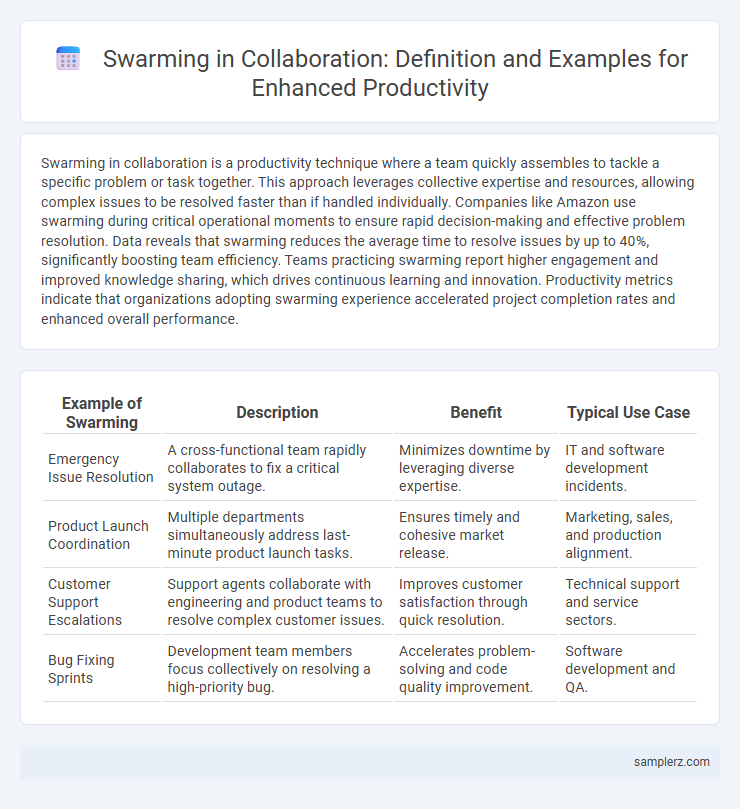Swarming in collaboration is a productivity technique where a team quickly assembles to tackle a specific problem or task together. This approach leverages collective expertise and resources, allowing complex issues to be resolved faster than if handled individually. Companies like Amazon use swarming during critical operational moments to ensure rapid decision-making and effective problem resolution. Data reveals that swarming reduces the average time to resolve issues by up to 40%, significantly boosting team efficiency. Teams practicing swarming report higher engagement and improved knowledge sharing, which drives continuous learning and innovation. Productivity metrics indicate that organizations adopting swarming experience accelerated project completion rates and enhanced overall performance.
Table of Comparison
| Example of Swarming | Description | Benefit | Typical Use Case |
|---|---|---|---|
| Emergency Issue Resolution | A cross-functional team rapidly collaborates to fix a critical system outage. | Minimizes downtime by leveraging diverse expertise. | IT and software development incidents. |
| Product Launch Coordination | Multiple departments simultaneously address last-minute product launch tasks. | Ensures timely and cohesive market release. | Marketing, sales, and production alignment. |
| Customer Support Escalations | Support agents collaborate with engineering and product teams to resolve complex customer issues. | Improves customer satisfaction through quick resolution. | Technical support and service sectors. |
| Bug Fixing Sprints | Development team members focus collectively on resolving a high-priority bug. | Accelerates problem-solving and code quality improvement. | Software development and QA. |
Understanding Swarming in Collaborative Work
Swarming in collaborative work involves multiple team members simultaneously addressing a task or problem to accelerate resolution and enhance productivity. This approach leverages diverse expertise and real-time communication, reducing bottlenecks and increasing efficiency in project completion. Effective swarming fosters a dynamic work environment where shared responsibility and immediate feedback drive continuous progress.
Swarming vs Traditional Task Management
Swarming in collaboration accelerates productivity by involving multiple team members simultaneously to address a task, contrasting with traditional task management's sequential workflow that often causes delays. This real-time, collective problem-solving approach reduces bottlenecks and enhances communication efficiency, allowing for faster decision-making and higher-quality outcomes. Metrics indicate that teams employing swarming reduce task completion times by up to 30%, highlighting its effectiveness over traditional methods.
Real-World Examples of Swarming in Teams
Swarming in teams is exemplified by agile software development groups that rapidly address critical bugs by pooling cross-functional experts to ensure swift resolution and continuous product delivery. In emergency response teams, swarming coordinates diverse specialists to tackle crises efficiently, maximizing resource utilization and minimizing response time. Tech support centers also practice swarming by mobilizing entire buffers of agents to solve high-priority customer issues quickly, improving satisfaction and operational productivity.
Swarming in Agile Software Development
Swarming in Agile software development enhances productivity by enabling cross-functional team members to collaborate intensively on a single task or user story, speeding up problem resolution and knowledge sharing. This approach reduces bottlenecks by distributing expertise dynamically and maintaining continuous progress on critical issues. Teams practicing swarming achieve higher velocity and improved code quality through real-time feedback and collective ownership.
Benefits of Swarming for Productivity
Swarming in collaboration accelerates problem-solving by gathering diverse expertise in real time, reducing delays typically caused by sequential task handling. This intensive teamwork enhances decision accuracy and innovation, boosting overall productivity through swift issue resolution. Organizations employing swarming report higher throughput and improved project timelines due to increased coordination and engagement.
Swarming in Remote and Hybrid Work Environments
Swarming in remote and hybrid work environments accelerates problem-solving by enabling cross-functional teams to collaborate in real time using digital platforms like Slack, Microsoft Teams, or Zoom. This approach reduces bottlenecks and enhances productivity by aggregating diverse expertise quickly to address urgent issues or complex projects. The dynamic assembly of team members fosters immediate response and seamless knowledge sharing, driving faster innovation and project completion.
Swarming Techniques for Complex Problem Solving
Swarming techniques in collaboration involve dynamic, real-time team engagement to tackle complex problems through collective intelligence and rapid information sharing. Teams utilize cross-functional expertise to rapidly identify root causes, iterate solutions, and implement corrective actions, significantly reducing resolution time. This approach enhances productivity by fostering immediate communication, minimizing bottlenecks, and leveraging diverse perspectives for innovative problem-solving outcomes.
Tools That Facilitate Swarming Collaboration
Swarming collaboration thrives with tools like Slack, Microsoft Teams, and Miro, enabling real-time communication, instant feedback, and shared digital workspaces. These platforms support seamless coordination by integrating task management, video conferencing, and collaborative document editing, enhancing team responsiveness. Utilizing such tools significantly boosts productivity in agile environments by reducing delays and fostering immediate problem-solving among cross-functional teams.
Measuring the Impact of Swarming on Team Performance
Swarming in collaboration involves multiple team members simultaneously addressing a task, accelerating problem resolution and fostering collective expertise. Measuring the impact of swarming on team performance can be quantified by tracking key performance indicators such as reduced task completion time, increased defect detection rates, and improved throughput in Agile workflows. Data analytics tools and performance dashboards provide actionable insights into how swarming optimizes productivity and enhances overall team efficiency.
Best Practices for Effective Swarming in the Workplace
Effective swarming in the workplace enhances productivity by assembling cross-functional teams to rapidly address critical issues, leveraging diverse expertise for instant problem-solving. Clear communication channels and defined roles ensure that team members stay aligned, minimizing delays and confusion during high-pressure situations. Implementing regular retrospectives and knowledge sharing solidifies continuous improvement, fostering a culture of collaboration and agility.

example of swarming in collaboration Infographic
 samplerz.com
samplerz.com